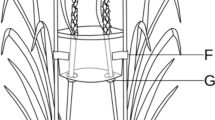Abstract
Electroantennograms were recorded from the grape borerXylotrechus pyrrhoderus in response to serial dilutions of male sex pheromone components, (2S,3S)-octanediol and (2S)-hydroxy-3-octanone, and to 100 μg of their optical isomers and host plant substances. Female antennae always responded more strongly than male antennae. Antennae of both sexes were highly sensitive to (2S)-hydroxy-3-octanone. F/M ratio (female to male EAG value) was greater for male sex pheromone components, especially (2S,3S)-octanediol, and their optical isomers than plant substances. Antennal sensitivity to optical isomers (2R,3R-octanediol and 2S,3R-octanediol) was lower than true pheromone components.
Similar content being viewed by others
References
Boeckh, J., Sass, H., andWharton, D.R.A. 1970. Antennal receptors: Reactions to female sex attractant inPeriplaneta americana.Science 168:589.
Chuman, T., Mochizuki, K., Mori, M., Kohno, M., Kato, K., Mori, H., andMori, K. 1982. Behavioral and electroantennogram responses of male cigarette beetle (Lasioderma serricorne F.) to optically active serricornis.Agric. Biol. Chem. 46:3109–3112.
Dickens, J.C., Gutmann, A., Payne, T.L., Ryker, L.C., andRudinsky, J.A. 1983. Antennal olfactory responsiveness of Douglas-fir beetle,Dendroctonus pseudotsugae Hopkins (Coleoptera: Scolytidae) to pheromones and host odors.J. Chem. Ecol. 9:1383–1395.
Dyer, L.J., andSeabrook, W.D. 1975. Evidence for the presence of acceptor sites for different terpenes on one receptor cell in maleMonochamus notatus (Drury) (Coleoptera: Cerambycidae).J. Chem. Ecol. 1:523–530.
Dyer, L.J., andSeabrook, W.D. 1978. Some aspects of oviposition site selection inMonochamus notatus andM. scutellatus (Coleoptera: Cerambycidae).J. Chem. Ecol. 4:199–210.
Grant, G.G. 1971. Electroantennogram responses to the scent brush secretions of several male moths.Ann. Entomol. Soc. Am. 64:1428–1431.
Grant, A.J., andLanier, G.N. 1982. Electroantennogram responses ofScolytus multistriatus (Coleoptera: Scolytidae) to its pheromone components and to associated compounds.J. Chem. Ecol. 8:1333–1344.
Grant, G.G., Bradly, U.E., andBrand, J.M. 1972. Male army worm scent brush secretions: Identification and electroantennogram study major components.Ann. Entomol. Soc. Am. 65:1224–1227.
Gutmann, A., Payne, T.L., Roberts, E.A., Schulte-Elte, K.-H., Giersch, W., andOhloff, G. 1981. Antennal olfactory response of boll weevil to grandlure and vicinal dimethyl analogs.J. Chem. Ecol. 7:919–926.
Iwabuchi, K. 1982. Mating behavior ofXylotrechus pyrrhoderus Bates (Coleoptera: Cerambycidae). I. Behavioral sequences and existence of the male sex pheromone.Appl. Entomol. Zool. 17:494–500.
Light, D.M. 1983. Sensitivity of antennae of male and femaleIps paraconfusus (Coleoptera: Scolytidae) to its pheromone and other behavior-modifying chemicals.J. Chem. Ecol. 9:585–606.
Mori, K. 1974. Synthesis ofexo-brevicomin, the pheromone of western pine beetle, to obtain optically active forms of known absolute configuration.Tetrahedron 30:4223–4227.
Nishino, C., Tobin, T.R., andBowers, W.S. 1977. Electroantennogram responses of the American cockroach to germacrene D sex pheromone mimic.J. Insect Physiol. 23:415–419.
Nishino, C., Takayanagi, H., andKimira, R. 1980. Electroantennogram and behavioral responses of the American cockroach to sex pheromone mimic.Comp. Biochem. Physiol. 66A:393–398.
Payne, T.L. 1971. Bark beetle olfaction. 1. Electroantennogram responses of the southern pine beetle (Coleoptera: Scolytidae) to its aggregation pheromone frontalin.Ann. Entomol. Soc. Am. 64:266–268.
Payne, T.L., andFinn, W.E. 1977. Pheromone receptor system in the females of the greater wax mothGalleria mellonella.J. Insect Physiol. 23:879–881.
Payne, T.L., Shorey, H.H., andGaston, L.K. 1973. Sex pheromones of Lepidoptera. XXXVIII. Electroantennogram responses inAutographa californica tocis-7-dodecenyl acetate and related compounds.Ann. Entomol. Soc. Am. 66:703–704.
Payne, T.L., Richerson, J.V., Dickens, J.C., West, J.R., Mori, K., Berisford, C.W., Hedden, R.L., Vité, J.P., andBlum, M.S. 1982. Southern pine beetle: Olfactory receptor and behavior discrimination of enantiomers of the attractant pheromone frontalin.J. Chem. Ecol. 8:873–881.
Roelofs, W.L., andComeau, A. 1971. Sex pheromone perception: Electroantennogram responses of the red-banded leaf roller moth.J. Insect Physiol. 17:1969–1982.
Sakai, T.,Nakagawa, Y.,Takahashi, J.,Iwabuchi, K., andIshii, K. 1984. Isolation and identification of the male sex pheromone of the grape borerXylotrechus pyrrhoderus Bates (Coleoptera: Cerambycidae).Chem. Lett. 263–264.
Schneider, D., Lacker, V., andKaissling, K.-H. 1964. Die Reaktionweise und das Reaktionsspektrum von Riechzellen beiAntheraea Perny.Z. Vgl. Physiol. 48:632–662.
Seabrook, W.D. 1978. Neurobiological contributions to understanding insect pheromone systems.Annu. Rev. Entomol. 23:471–485.
Seabrook, W.D., Hirai, K., Shorey, H.H., andGaston, L.K. 1979. Maturation and senescence of an insect chemosensory response.J. Chem. Ecol. 5:587–594.
Seibt, W., Schneider, D., andEisner, T. 1972. Hairpencils, wing pouches and courtship of the butterflyDanaus chrysippus.Z. Tierpsychol. 31:513–530.
Skirkyavichus, A.V., andSkirkyavichene, Z. Yu. 1978. The sensitivity of the olfactory receptors of adult males of different ages of the codling moth totrans,trans-8,10-dodecadien-1-ol.Khemoretseptsiya Nasekomykh 3:61–68.
Skirkyavichus, A.V., andSkirkyavichene, Z. Yu. 1979. The effect of insect age on the degree of electroantennogram amplitude caused by pheromone.Khemoretseptsiya Nasekomykh 4:23–43.
Wildenradt, H.L., Christensen, E.N., Stackler, B., Caputi, A., Jr., Slinkard, K., andScutt, K. 1975. Volatile constituents of grape leaves. I.Vitis vinifera variety “Chenin blanc.”Am. J. Enol. Viticult. 26:148–153.
Author information
Authors and Affiliations
Rights and permissions
About this article
Cite this article
Iwabuchi, K., Takahashi, J., Nakagawa, Y. et al. Electroantennogram responses of grape borerXylotrechus pyrrhoderus bates (Coleoptera: Cerambycidae) to its male sex pheromone components. J Chem Ecol 11, 819–828 (1985). https://doi.org/10.1007/BF01012070
Received:
Accepted:
Issue Date:
DOI: https://doi.org/10.1007/BF01012070




